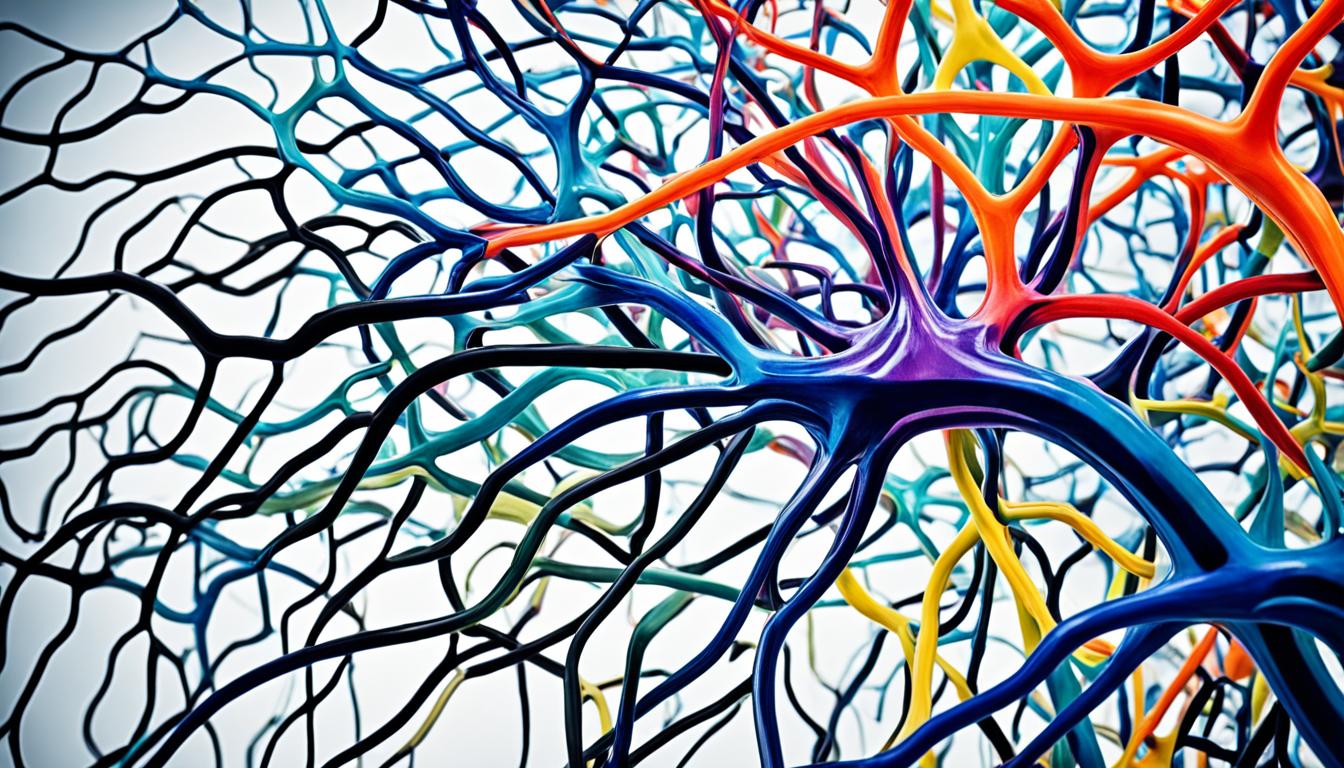Steele-Richardson-Olszewski syndrome is a rare condition affecting the brain. It is also known as progressive supranuclear palsy. This disease leads to the slow destruction of brain cells in key areas. These include the brainstem, cerebral cortex, cerebellum, and basal ganglia. These areas control our movements and coordination.
People with this syndrome find that walking, balance, eye movements, and swallowing become harder. Over time, these difficulties increase. This makes daily life activities challenging.
Complications like pneumonia and swallowing issues can occur. These can reduce a person’s quality of life. Unfortunately, there’s no cure for this syndrome yet. But, treatment aims to help manage symptoms and improve life quality.
Key Takeaways:
- Steele-Richardson-Olszewski syndrome is a rare brain condition.
- The disease affects cells in critical brain areas for movement and coordination.
- Symptoms include difficulties with walking, balance, eye movements, and swallowing.
- As it progresses, complications like pneumonia and swallowing troubles may occur.
- There’s no cure for this syndrome, so treatment helps manage symptoms for better life quality.
Symptoms and Diagnosis of Steele-Richardson-Olszewski Syndrome
Steele-Richardson-Olszewski syndrome is a serious brain disorder. It shows with many different symptoms. Knowing these signs early is key for spotting the disease and treating it well.
Common symptoms of Steele-Richardson-Olszewski syndrome:
- Loss of balance while walking: People with the syndrome find it hard to stay steady while they walk.
- Difficulty aiming the eyes properly: Their eyes might not move up or down like they should.
- Stiffness and awkward movements: They might move very stiffly and jerk around a lot.
- Slow or slurred speech: Talking too slowly or unclearly can be an issue.
- Trouble swallowing: This disease can make eating and drinking difficult.
- Sensitivity to bright light: Bright lights could bother their eyes a lot.
- Sleep disturbances: They might have trouble sleeping at night or feel very tired during the day.
- Loss of interest in pleasurable activities: Things they used to love doing don’t make them happy anymore.
- Impulsive behavior: They could act without thinking a lot more than usual.
- Trouble with reasoning and decision-making: Thinking and making choices might get harder for them.
- Depression and anxiety: Feeling very sad or worried is common with this syndrome.
- Surprised or frightened facial expression: Their face might always look surprised or scared.
- Dizziness: They might feel dizzy or like they’re going to faint.
The signs of this syndrome can change from person to person. They might get worse over time. They can also look like other brain diseases like Parkinson’s or dementia.
Diagnosis:
To diagnose this syndrome, a doctor who knows a lot about brain movement disorders needs to check everything. They will:
- Do tests to check thinking, memory, and using words. These can tell a lot about the disease.
- Take pictures of the brain using MRI or PET scans. These show if the brain looks different because of the syndrome.
- Look hard at how the eyes move. This can show more signs of the disease.
By looking at all these tests and the person’s history, the doctor can figure out if it’s Steele-Richardson-Olszewski syndrome for sure.
| Symptom | Prevalence | Explanation |
|---|---|---|
| Loss of balance while walking | High | The deterioration of brainstem cells affects coordination and balance. |
| Difficulty aiming the eyes properly | Moderate | Disruption in eye movement control due to brainstem and basal ganglia involvement. |
| Stiffness and awkward movements | High | Impaired function of basal ganglia and motor control pathways. |
| Slow or slurred speech | High | Neurological damage affecting speech production and motor control. |
| Trouble swallowing | High | Dysfunction in the muscles responsible for swallowing due to brainstem involvement. |
| Sensitivity to bright light | Moderate | Increased sensitivity of retinal ganglion cells to light stimulation. |
| Sleep disturbances | Moderate | Neuronal dysfunction affecting sleep-wake regulation in brainstem structures. |
| Loss of interest in pleasurable activities | Moderate | Affected brain regions linked to reward and pleasure pathways. |
| Impulsive behavior | Low | Frontal-subcortical circuit abnormalities contributing to impulse control problems. |
| Trouble with reasoning and decision-making | Moderate | Impaired executive functions due to frontal lobe involvement. |
| Depression and anxiety | Moderate | Altered neurotransmitter levels and neurodegeneration in brain regions implicated in mood regulation. |
| Surprised or frightened facial expression | High | Facial muscle rigidity and dopaminergic dysfunction leading to a fixed expression. |
| Dizziness | Low | Impaired vestibular function due to brainstem involvement. |
Causes and Treatment of Steele-Richardson-Olszewski Syndrome
Steele-Richardson-Olszewski syndrome is a rare neurodegenerative disorder. The exact causes are not fully known yet. But it’s likely to come from a mix of genes and the environment.
It causes a buildup of tau protein in nerve cells, which damages them. This leads to problems with movement, balance, and other brain functions over time.
At the moment, treatments mostly help with the symptoms. There’s no cure. Luckily, treatments used for Parkinson’s disease can make things better for some. These include meds to ease movement issues, and therapies to help move and talk better.
Right now, researchers are looking for ways to treat the root cause. They’re trying new drugs in clinical trials. These drugs intend to lower tau protein levels or clear toxic brain build-ups. This could slow or stop the disease from getting worse.
Although we are still learning about Steele-Richardson-Olszewski syndrome, we know that tau protein build-up is a key player. Even with only symptom treatments available today, there’s hope. Research and trials might give us better ways to help those with this condition in the future.

